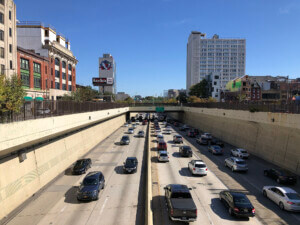The top editor at the Philadelphia Inquirer is out after the paper ran a woefully ill-advised headline last week that equated the loss of Black lives with the loss of buildings.
On Tuesday, June 2, the Inquirer published an article by Pulitzer Prize-winning resident architecture critic Inga Saffron that acknowledged that racial inequality is baked into America’s urban built environment. More specifically, Saffron lamented the looting and destruction of property that erupted last week in Philadelphia on the fringes of the largely peaceful protests and demonstrations staged in reaction to the death of George Floyd, a Black Minneapolis resident killed at the hands of that city’s police department on May 25.
“Hardly any building on Walnut and Chestnut Streets was left unscathed, and two mid-19th century structures just east of Rittenhouse Square were gutted by fire,” Saffron wrote, noting that the anger that fueled much of the destruction was “fully justified.”
“Their chances of survival are slim, which means there could soon be a gaping hole in the heart of Philadelphia, in one of its most iconic and historic neighborhoods,” said Saffron of the fire-ravaged Center City structures.
The article in question was accompanied by a headline—“Buildings Matter, too”—that, while succinct, managed to pack in plenty of very valid questions regarding the editorial decision-making process and culture at the Inquirer.
The offending headline, a tone-deaf riff on Black Lives Matter, drew widespread censure and was quickly yanked by the paper. (To be clear, Saffron did not pen the headline, and some architects and architecture critics have been quick to defend the article itself although others have found its timing and tone to be insensitive as well).
Two new attempts at an appropriate headline followed (the current headline now reads: “Damaging buildings disproportionately hurts the people protesters are trying to uplift) as did an Editor’s Note that reads: “A headline published in Tuesday’s Inquirer was offensive, inappropriate and we should not have printed it. We deeply regret that we did. We also know that an apology on its own is not sufficient. We need to do better. We’ve heard that loud and clear, including from our own staff. We will. A detailed explanation of how we got this so wrong can be found here.”
Saffron also shared her own regrets about the headline via Twitter.
By the end of the week, the Inquirer’s executive editor and senior vice president, Stan Wischnowski, had resigned amid internal furor at the paper. Wischnowski had been at the Inquirer for 20 years. A decade of his tenure was at the helm as executive editor.
Per the Inquirer, Wischnowski’s last day on the job will be June 12. His replacement has not yet been named. In a statement announcing his departure, publisher Lisa Hughes relayed to the paper’s staff that: “We will use this moment to evaluate the organizational structure and processes of the newsroom, assess what we need, and look both internally and externally for a seasoned leader who embodies our values, embraces our shared strategy, and understands the diversity of the communities we serve.”
Wischnowski’s resignation followed roughly 30 of the paper’s 200-plus staffers staging a (virtual) walkout this past Thursday in protest of the decision to run the initial headline. The previous day, nearly 50 staff members of color had submitted an open letter to the Inquirer’s leadership expressing their outrage and announcing their collective plan to call “in sick and tired. Sick and tired of pretending things are OK. Sick and tired of not being heard.”
“We’re tired of hasty apologies and silent corrections when someone screws up. We’re tired of workshops and worksheets and diversity panels,” read the letter. “We’re tired of working for months and years to gain the trust of our communities—communities that have long had good reason to not trust our profession—only to see that trust eroded in an instant by careless, unempathetic decisions.”
The letter continues:
“This is not the start of a conversation; this conversation has been started time and time again. We demand action. We demand a plan, with deadlines. We demand full, transparent commitment to changing how we do business. No more ‘handling internally.’ No more quiet corrections. If we are to walk into a better world, we need to do it with our chests forward—acknowledge and accept where we make mistakes, and show how we learn from them. Your embarrassment is not worth more than our humanity.”
The firestorm at the Inquirer came largely at the same time as an unprecedented revolt at the New York Times in which a countless number of current and former staffers and editorial contributors publicly expressed their outrage with the decision to run an overtly fascist opinion piece written by Senator Tom Cotton, a Republican from Arkansas, that suggests protests and uprisings against racial injustice should be quelled with the strength of the U.S. military. Over the weekend, the paper’s frequently lambasted opinion editor, James Bennet, stepped down from the role. In announcing Bennet’s departure, Times publisher A.G. Sulzberger admitted that a “serious breakdown in the editing process” occurred leading up to the publication of Cotton’s op-ed.











